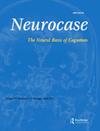日语语义性痴呆患者词汇决策与理解的双重分离:基于汉字特征加工的研究。
IF 0.6
4区 医学
Q4 CLINICAL NEUROLOGY
引用次数: 0
摘要
我们报告了一例日语语意性痴呆患者,其在词汇决策任务(LDT)中的汉字视觉表现低于听觉表现,但在阅读理解任务(RCT)中的视觉表现较好。在随机对照试验中,患者从单字汉字(例如,“rescue”/kyu zyo/→”/tasukeru/)或正字法邻接词(例如,“rest”/kyu soku/→“rest”/kyu ke /)中推测意义。在LDT中,他依靠单个汉字的语义联想,将非词误认为是真词。汉字的符号特征可能促进了RCT,同时使LDT的性能复杂化。本文章由计算机程序翻译,如有差异,请以英文原文为准。
Double dissociation between lexical decision and comprehension in a Japanese patient with semantic dementia: based on the characteristic processing of Kanji.
We report the case of a Japanese-speaking patient with semantic dementia who showed lower kanji visual performance than auditory performance in a lexical decision task (LDT), but better visual performance in a reading comprehension task (RCT). In the RCT, the patient presumed meanings from single-character kanji (e.g., "rescue" /kyuʀzyo/ → ける "help" /tasukeru/) or orthographic neighbors (e.g., "rest" /kyuʀsoku/ → "rest" /kyuʀkeʀ/). In the LDT, he misidentified non-words as real words by relying on semantic associations of individual kanji characters. The logographic characteristics of kanji may have facilitated RCT while complicating LDT performance.
求助全文
通过发布文献求助,成功后即可免费获取论文全文。
去求助
来源期刊

Neurocase
医学-精神病学
CiteScore
1.40
自引率
12.50%
发文量
70
审稿时长
6-12 weeks
期刊介绍:
Neurocase is a rapid response journal of case studies and innovative group studies in neuropsychology, neuropsychiatry and behavioral neurology that speak to the neural basis of cognition. Four types of manuscript are considered for publication: single case investigations that bear directly on issues of relevance to theoretical issues or brain-behavior relationships; group studies of subjects with brain dysfunction that address issues relevant to the understanding of human cognition; reviews of important topics in the domains of neuropsychology, neuropsychiatry and behavioral neurology; and brief reports (up to 2500 words) that replicate previous reports dealing with issues of considerable significance. Of particular interest are investigations that include precise anatomical localization of lesions or neural activity via imaging or other techniques, as well as studies of patients with neurodegenerative diseases, since these diseases are becoming more common as our population ages. Topic reviews are included in most issues.
 求助内容:
求助内容: 应助结果提醒方式:
应助结果提醒方式:


